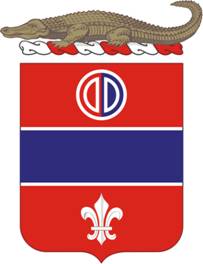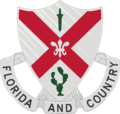
The 31st Infantry Division ("Dixie") was an infantry division of the United States Army National Guard, active almost continuously from 1917 to 1968. Composed of men from Alabama, Florida, Georgia, Louisiana, Michigan, Illinois, and Mississippi at various points in its existence, the division saw service in both World War I and World War II, and was mobilized during the Korean War, although it was not sent overseas in the latter.

The Florida Army National Guard is Florida's component of the United States Army and the United States National Guard. In the United States, the Army National Guard comprises approximately one half of the federal army's available combat forces and approximately one third of its support organization. Federal coordination of various state National Guard units are maintained through the National Guard Bureau. The Florida Army National Guard was composed of approximately 10,000 soldiers. The main state training grounds is Camp Blanding.

The Georgia Army National Guard is the Army National Guard component of the Georgia National Guard, administratively part of the Georgia Department of Defense. It consists of more than 11,100 citizen-soldiers training in more than 79 hometown armories and regional facilities across the state. Georgia’s Army Guard is the sixth largest in the nation and includes combat, combat support and combat service support units.
The Mississippi Army National Guard is the Army National Guard component of the Mississippi National Guard. It was originally formed in 1798. It is a component of the United States Army and the United States National Guard. It is managed by the Mississippi Military Department.

The 39th Infantry Division was an infantry formation of the Army National Guard, originally formed as the 18th Division in 1917. The division consisted of troops from Arkansas, Louisiana, and Mississippi. After training at Camp Beauregard, Louisiana, the division was deployed to France but did not see combat before the end of World War I. In July 1923 the division was re-designated as the 31st Infantry Division. The 39th Infantry Division was reactivated after World War II with troops from Louisiana and Arkansas and its headquarters in Louisiana. In 1967, the 39th Infantry Division was reorganized to become the 39th Infantry Brigade (Separate). Its headquarters was in Little Rock and the unit consisted entirely of troops from Arkansas.

The 108th Cavalry Regiment is a cavalry regiment of the Georgia and Louisiana Army National Guards of the United States Army.

The 156th Infantry Regiment is an infantry regiment in the United States Army and the Louisiana National Guard. It began as a Confederate Army unit in 1861, and surrendered to the Union at the Battle of Appomattox Court House in 1865. It was reformed in 1878 as a militia unit, and reorganized into the Louisiana National Guard in 1899. It saw support service in World War I. In world War II it served as a guard battalion in Europe, for which it added a lion to its coat of arms to symbolize its service in northern France. It deployed twice during the Iraq war.

The 48th Armored Division was a division of the United States Army National Guard from September 1946 until 1968. Most of its units were part of the Florida Army National Guard and the Georgia Army National Guard. From 1946 to 1955 it was an infantry division. During World War II the denotation 48th Infantry Division was a 'phantom division' created for Operation Quicksilver, part of Operation Fortitude South II.

The 107th Cavalry Regiment, Ohio Army National Guard, is a parent regiment under the U.S. Army Regimental System, with headquarters at Hamilton, Ohio. It currently consists of the 2nd Squadron, 107th Cavalry Regiment, part of the 37th Infantry Brigade Combat Team (BUCKEYE), Ohio National Guard located throughout southwest Ohio.
The 154th Regiment (Regional Training Institute) ("Third Arkansas") is a training regiment/institute of the Army National Guard. Most of its history before the 1990s can be traced to the 154th Infantry Regiment which was created from the 1st and 2nd Battalions of the 3rd Arkansas Infantry Regiment, Arkansas National Guard, in 1917. The Regiment was activated as for World War I, re-designated as the 154th Infantry and shipped to France as a part of the 39th Infantry Division, but became a replacement regiment and its personnel were reassigned to other American Expeditionary Force (AEF) units.

First Squadron, 153rd Cavalry Regiment "Darkhorse" is an element of the Florida Army National Guard, headquartered in Panama City, Florida with units throughout the Panhandle. It was formerly 3rd Battalion, 124th Infantry and officially converted to cavalry on 1 September 2007 when the 53rd Infantry Brigade converted from a "separate brigade" to the brigade combat team structure.

The Governor's Guards is a historic unit of the Florida Army National Guard, stationed in Tallahassee, Florida. Its current designation is Troop C, 1st Squadron, 153rd Cavalry. The unit has one of the oldest continuous lineages in the Florida National Guard. In 1857, Captain John Parkhill, his brother Samuel M. Parkhill, and Theordore Brevard, Jr. formed a mounted company of "Leon Volunteers" to fight in the Third Seminole War, where John Parkhill was killed in action. John Parkhill's cousin, Captain George W. Parkhill and his brother, Richard C. Parkhill formed a new company called the "Governor's Guards" circa 1859-1860 which later changed its name to "Howell Guards" and fought with the Second Florida Infantry during the Civil War. After the war, the company reorganized as "Governor's Guards", a local militia company, under the command of Captain Alexander Moseley and have had a near-continuous lineage henceforth. The Governor's Guards served as an infantry unit for most of its existence, including in the Civil War, World War I, World War II, the Iraq War and the Global War on Terrorism. The unit consolidated with the Franklin Guards, a detachment in Apalachicola and since 2007 has been Charlie Troop, a dismounted infantry reconnaissance troop.

The 116th Field Artillery is a regiment of the Florida Army National Guard. Currently there are two battalions; 2-116th FA is fires battalion for the 53rd Brigade Combat Team, and 3-116th (HIMARS) is part of the 164th Air Defense Artillery Brigade, both of the Florida Army National Guard.

The Chatham Artillery is an artillery unit that has played a leading role in the history of the state of Georgia since the American Revolution. In 1776, Thomas Lee was authorized to enlist a provincial company of artillery for the defense of Savannah, the first such unit in Georgia's history. Commanded by Joseph Woodruff, they defended the right flank of American forces when the British attacked Savannah. They saw service in the Oconnee wars, The Embargo Wars, and The War of 1812. They were part of the force that occupied Fort Pulaski that opened the American Civil War, and served in and around Savannah and Charleston South Carolina before joining General Johnston's forces in Columbia, South Carolina. After the reorganization in 1872, they mustered out to the border with Mexico, to stop Pancho Villa's raids in the United States. They served with the "Dixie Division" in France during World War I, and landed on Normandy Beach on D-day plus 4 in World War II. They breached the Siegfried Line, and were at the Elbe River when the war ended. In 2005 they were mobilized again into federal service, as an element of the 48th Brigade Combat team serving in Iraq, part of Operation Iraqi Freedom. The Chatham Artillery was re-mobilized in 2009 to support Operation Enduring Freedom in Afghanistan, personally training Afghan Troops and Police Forces. They were demobilized in 2010 at Fort Stewart, Georgia. Today they remain in service, as a modular artillery brigade of the Georgia Army National Guard, the 118th Field Artillery.
Company A, 146th Signal Battalion is a unit of the Florida Army National Guard, stationed in Jacksonville, Florida. The company dates back to 1887 with the founding of the "Metropolitan Light Infantry". For its first 68 years the unit served as an infantry company and deployed as Company F, 124th Infantry during World War II. After WWII the unit reorganized again as infantry, then as a quartermaster company for eight years, and since February 1963 the Metropolitan Light Infantry has been a signal company.

The 868th Engineer Company "Suwannee Rifles" is a unit of the Florida Army National Guard, stationed in Live Oak, Florida. The company has one of the oldest continuous lineages in the Florida National Guard, starting out as an independent company of infantry in 1884. During its first 71 years, the Suwannee Rifles served as an infantry company and deployed as Company E, 124th Infantry during World War II. After WWII the unit reorganized again as infantry, then as an armor company for thirteen years, and since December 1968 the Suwannee Rifles has been an engineer company.
The 114th Field Artillery Regiment is a field artillery regiment of the Mississippi Army National Guard. The regiment's 2nd Battalion is the cannon battalion assigned to the 155th Armored Brigade Combat Team.
The 117th Field Artillery Regiment is a field artillery regiment of the Alabama Army National Guard. The regiment's 1st Battalion is a cannon battalion assigned to the 142nd Field Artillery Brigade.
The 118th Field Artillery Regiment is a field artillery regiment of the Georgia Army National Guard. The regiment's 1st Battalion is the cannon battalion assigned to the 48th Infantry Brigade Combat Team. It is one of several National Guard units with colonial roots and campaign credit for the War of 1812.
The 122nd Field Artillery Regiment is a field artillery regiment of the Illinois Army National Guard. The regiment's 2nd Battalion is the cannon battalion assigned to the 33rd Infantry Brigade Combat Team.























